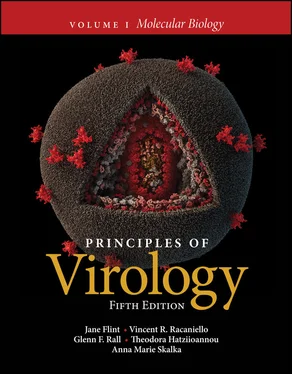Jane Flint - Principles of Virology, Volume 1
Здесь есть возможность читать онлайн «Jane Flint - Principles of Virology, Volume 1» — ознакомительный отрывок электронной книги совершенно бесплатно, а после прочтения отрывка купить полную версию. В некоторых случаях можно слушать аудио, скачать через торрент в формате fb2 и присутствует краткое содержание. Жанр: unrecognised, на английском языке. Описание произведения, (предисловие) а так же отзывы посетителей доступны на портале библиотеки ЛибКат.
- Название:Principles of Virology, Volume 1
- Автор:
- Жанр:
- Год:неизвестен
- ISBN:нет данных
- Рейтинг книги:5 / 5. Голосов: 1
-
Избранное:Добавить в избранное
- Отзывы:
-
Ваша оценка:
- 100
- 1
- 2
- 3
- 4
- 5
Principles of Virology, Volume 1: краткое содержание, описание и аннотация
Предлагаем к чтению аннотацию, описание, краткое содержание или предисловие (зависит от того, что написал сам автор книги «Principles of Virology, Volume 1»). Если вы не нашли необходимую информацию о книге — напишите в комментариях, мы постараемся отыскать её.
Volume I: Molecular Biology
Volume II: Pathogenesis and Control
Principles of Virology, Fifth Edition
Principles of Virology, Volume 1 — читать онлайн ознакомительный отрывок
Ниже представлен текст книги, разбитый по страницам. Система сохранения места последней прочитанной страницы, позволяет с удобством читать онлайн бесплатно книгу «Principles of Virology, Volume 1», без необходимости каждый раз заново искать на чём Вы остановились. Поставьте закладку, и сможете в любой момент перейти на страницу, на которой закончили чтение.
Интервал:
Закладка:
Theodora Hatziioannouis a Research Associate Professor at Rockefeller University in New York. Throughout her career, Dr. Hatziioannou has worked on multiple viruses, with a particular focus on retroviruses and the molecular mechanisms that govern virus tropism and on the improvement of animal models for human disease. She is actively involved in teaching programs at the Rockefeller University and the Albert Einstein College of Medicine, is an editor of Journal of General Virology , and serves as a reviewer for multiple scientific journals and NIH grant review panels.
Anna Marie Skalkais a Professor Emerita and former Senior Vice President for Basic Research at the Fox Chase Cancer Center in Philadelphia. Dr. Skalka’s major research interests are the molecular aspects of retrovirus biology. Dr. Skalka is internationally recognized for her contributions to the understanding of the biochemical mechanisms by which such viruses (including the AIDS virus) replicate and insert their genetic material into the host genome. Both an administrator and researcher, Dr. Skalka has been deeply involved in state, national, and international advisory groups concerned with the broader, societal implications of scientific research. She has also served on the editorial boards of peer-reviewed scientific journals and has been a member of scientific advisory boards including the National Cancer Institute Board of Scientific Counselors, the General Motors Cancer Research Foundation Awards Assembly, the Board of Governors of the American Academy of Microbiology, and the National Advisory Committee for the Pew Biomedical Scholars.
Key of Repetitive Elements

1 Foundations

Luria’s Credo
Viruses Defined
Why We Study VirusesViruses Are Everywhere Viruses Infect All Living Things Viruses Can Cause Human Disease Viruses Can Be Beneficial Viruses “R” Us Viruses Can Cross Species Boundaries Viruses Are Unique Tools To Study Biology
Virus Prehistory Viral Infections in Antiquity The First Vaccines Microorganisms as Pathogenic Agents
Discovery of Viruses
The Defining Properties of Viruses The Structural Simplicity of Virus Particles The Intracellular Parasitism of Viruses
Cataloging Animal Viruses The Classical System Classification by Genome Type: the Baltimore System
A Common Strategy for Viral Propagation
Perspectives
References
Study Questions
LINKS FOR CHAPTER 1
Video: Interview with Dr. Donald Henderson http://bit.ly/Virology_Henderson
This Week in Virology (TWIV): A weekly podcast about viruses featuring informal yet informative discussions and interviews with guests about the latest topics in the field http://www.microbe.tv/twiv
Marine viruses and insect defense http://bit.ly/Virology_Twiv301
Giants among viruses http://bit.ly/Virology_Twiv261
Whiter reefs, fresh breath http://www.microbe.tv/twiv/twiv-391/
Latest update of virus classification from the ICTV https://talk.ictvonline.org/taxonomy/
The abundant and diverse viruses of the seas http://bit.ly/Virology_3-20-09
How many viruses on Earth? http://bit.ly/Virology_9-6-13
Thus, we cannot reject the assumption that the effect of the filtered lymph is not due to toxicity, but rather to the ability of the agent to replicate.
F. LOEFFLER, 1898
Luria’s Credo
“There is an intrinsic simplicity of nature and the ultimate contribution of science resides in the discovery of unifying and simplifying generalizations, rather than in the description of isolated situations—in the visualization of simple, overall patterns rather than in the analysis of patchworks.” More than half a century has passed since Salvador Luria wrote this credo in the introduction to the classic textbook General Virology .
Despite an explosion of information in biology since Luria wrote these words, his vision of unity in diversity is as relevant now as it was then. That such unifying principles exist may not be obvious considering the bewildering array of viruses, genes, and proteins recognized in modern virology. Indeed, new viruses are being described regularly, and viral diseases such as acquired immunodeficiency syndrome (AIDS), hepatitis, and influenza continue to challenge our efforts to control them. Yet Luria’s credo still stands: even as our knowledge of viruses continues to increase, it is clear that their reproduction and survival depend on similar pathways. This insight has been hard-won over many years of observation, research, and debate; the history of virology is rich and instructive.
Viruses Defined
Viruses are microscopic infectious agents that can reproduce only inside a cell that they infect: they are obligate parasitesof their host cells. Viruses spread from cell to cell via infectious particles called virions, which contain genomes comprising RNA or DNA surrounded by a protective protein coat. Upon particle entry and disassociation in a host cell, the viral genome directs synthesis of viral components by cellular systems. Progeny virus particles are formed in the infected cell by de novo self-assembly from the newly synthesized components.
As will be discussed in the following chapters, advances in knowledge of the structure of virus particles and the mechanisms by which they are produced in their host cells have been accompanied by increasingly accurate definitions of these unique agents. The earliest pathogenic viruses, distinguished by their small size and dependence on a host organism for reproduction, emphasized the importance of viruses as agents of disease. But there are many other important reasons to study viruses.
Why We Study Viruses
Viruses Are Everywhere
Viruses are all around us, comprising an enormous proportion of our environment, in both number and total mass ( Box 1.1). All living things encounter billions of virus particles every day. For example, they enter our lungs in the 6 liters of air each of us inhales every minute; they enter our digestive systems with the food we eat; and they are transferred to our eyes, mouths, and other points of entry from the surfaces we touch and the people with whom we interact. Viral nucleic acids (the virome) can be found in the respiratory, gastrointestinal, and urogenital tracts even of normal, healthy individuals ( Fig. 1.1). Our bloodstreams harbor up to 100,000 virus particles per milliliter. In addition to viruses that can infect us, our intestinal tracts are loaded with myriad plant and insect viruses, as well as many hundreds of bacterial species that harbor their own constellations of viruses.
PRINCIPLES Foundations
Viruses are obligate intracellular parasites and depend on their host cell for all aspects of their reproduction.
The field of virology encompasses viral discovery; the study of virus structure and reproduction; and the importance of viruses in biology, ecology, and disease.
This text focuses primarily on viruses that infect vertebrates, especially humans, but it is important to keep in mind that viruses infect all living things including insects, plants, and bacteria.
Viruses are not solely pathogenic nuisances; they can be beneficial. Viruses contribute to ecological homeostasis, keep our immune responses activated and alert, and can be used as molecular flashlights to illuminate cellular processes.
Читать дальшеИнтервал:
Закладка:
Похожие книги на «Principles of Virology, Volume 1»
Представляем Вашему вниманию похожие книги на «Principles of Virology, Volume 1» списком для выбора. Мы отобрали схожую по названию и смыслу литературу в надежде предоставить читателям больше вариантов отыскать новые, интересные, ещё непрочитанные произведения.
Обсуждение, отзывы о книге «Principles of Virology, Volume 1» и просто собственные мнения читателей. Оставьте ваши комментарии, напишите, что Вы думаете о произведении, его смысле или главных героях. Укажите что конкретно понравилось, а что нет, и почему Вы так считаете.



